This seed bread is thick, hearty and filled with crunchy nutty texture. Enjoy with a thick smear of butter and a sprinkling of flaky sea salt.
If you’ve ever gone down the rabbit hole of whole wheat bread baking, you know it’s generally filled with dense breads and a sore jaw. I’ve had my share of experimenting with grains and heavy loaves. My mom still makes fun of my whole-wheat-everything streak back in college.
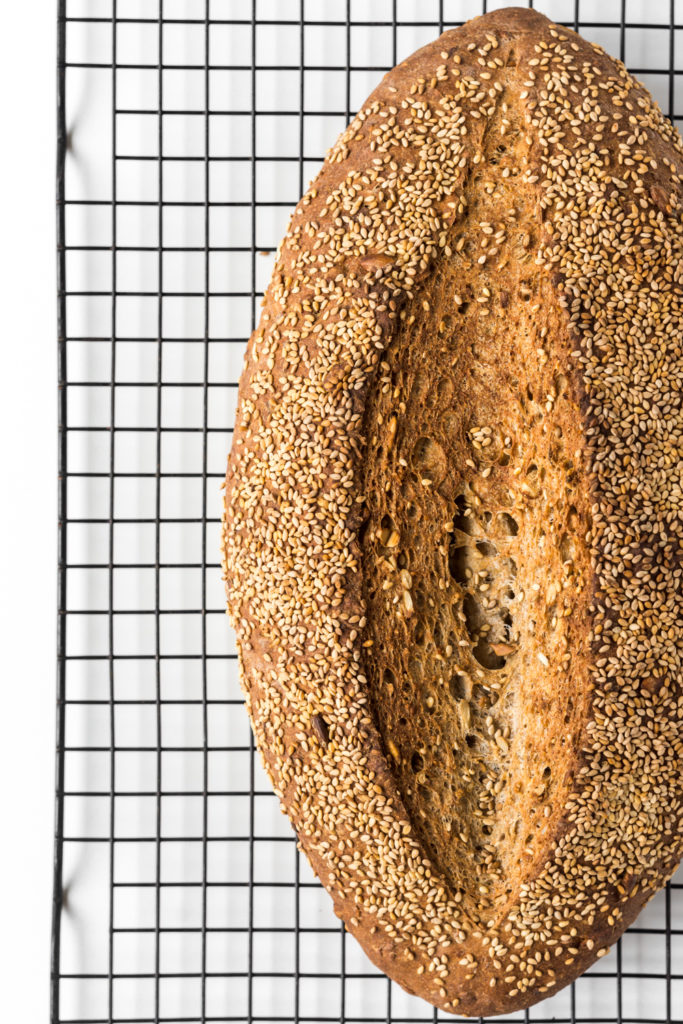
I came home during the summers and was so obsessed with whole grain recipes, I even made 100% whole wheat desserts (cookies, quick breads, and even laminated doughs). I remember proudly packing hard whole wheat banana cookies in my poor brother’s lunch and looking forward to the exciting new batch of whole wheat treats I was planning that afternoon.
Looking back now, I’m convinced he never ate them. And for good reason. They were terrible. Whole grain baking can be rough, especially if you stick with 100% whole wheat flour and choose to amp up the nutritional value with things like flax meal, oat bran and chia seeds.
Thankfully for everyone involved, I’ve moved past that season of hockey pucks, but I am still interested in finding ways to make edible baked goods with a touch of whole grains. This usually involves a portion of all-purpose flour to soften the texture, and it also means not using hard spring red wheat in tender pastries.
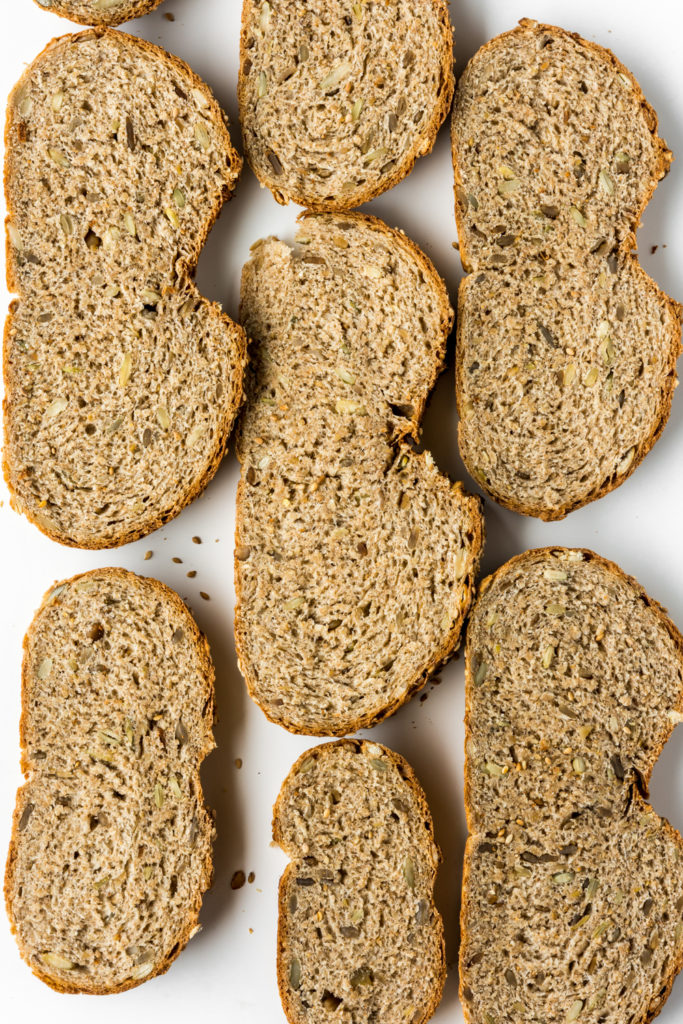
what's the best recipe for make whole grain bread?
When making yeasted breads with whole grain flours, there’s a host of new techniques pioneered by Peter Reinhart that maximize flavor and lift in the final breads.
In my opinion, he’s cracked the code for whole grain baking, and this seed bread recipe (from his book Peter Reinhart’s Whole Grain Breads) is one of my favorite new breads. It’s hearty and filled with a delicious mix of nutty seeds, yet it’s light and completely unlike any of my past whole wheat bread making experiences.
- it uses two pre-doughs that rest overnight: one softens the grains and activates dormant enzymes to maximize flavor (the soaker)
- the other uses a small amount of yeast to begin a slow, complex fermentation and gluten development (the preferment, or biga).
When combined the next day with a bit more flour, yeast and the seeds, the bread has a huge head start in terms of flavor and structural development. The recipe is simple, and the end result is incredibly satisfying.
If you want to complete the meal, serve it with this cozy cabbage soup! Otherwise, my favorite way to enjoy this bread is with a thick pat of butter and a sprinkling of flaky sea salt. There’s nothing more comforting than a loaf of warm, crusty bread on a cold winter night. This whole grain bread recipe will serve you better than any wheat-y recipe I cooked up years ago. It’s not a hockey puck, and for that my entire family is grateful.
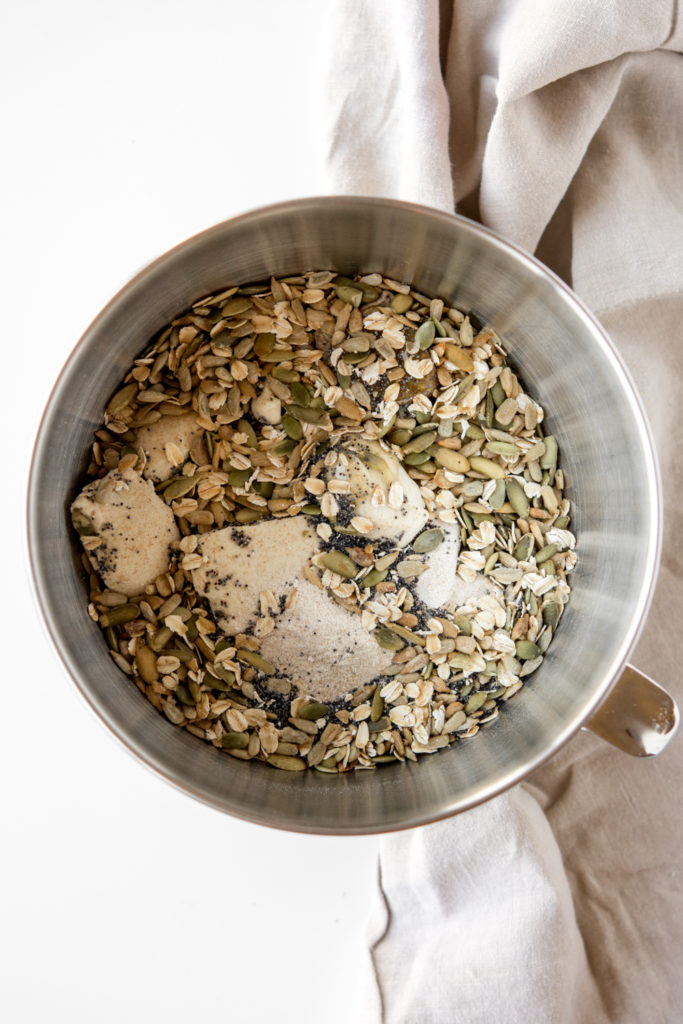

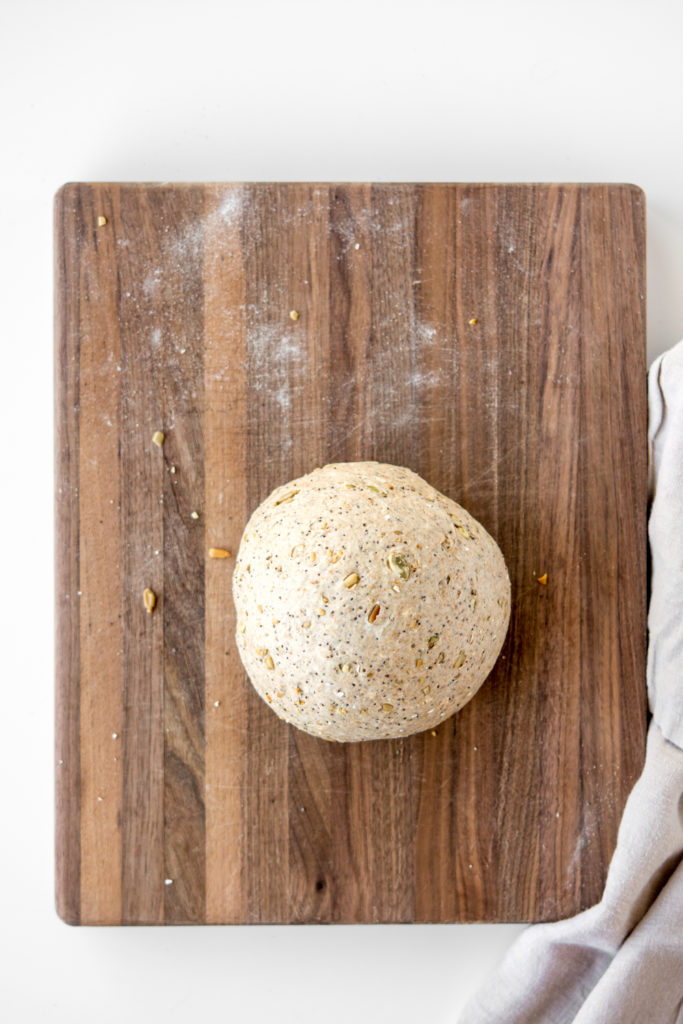
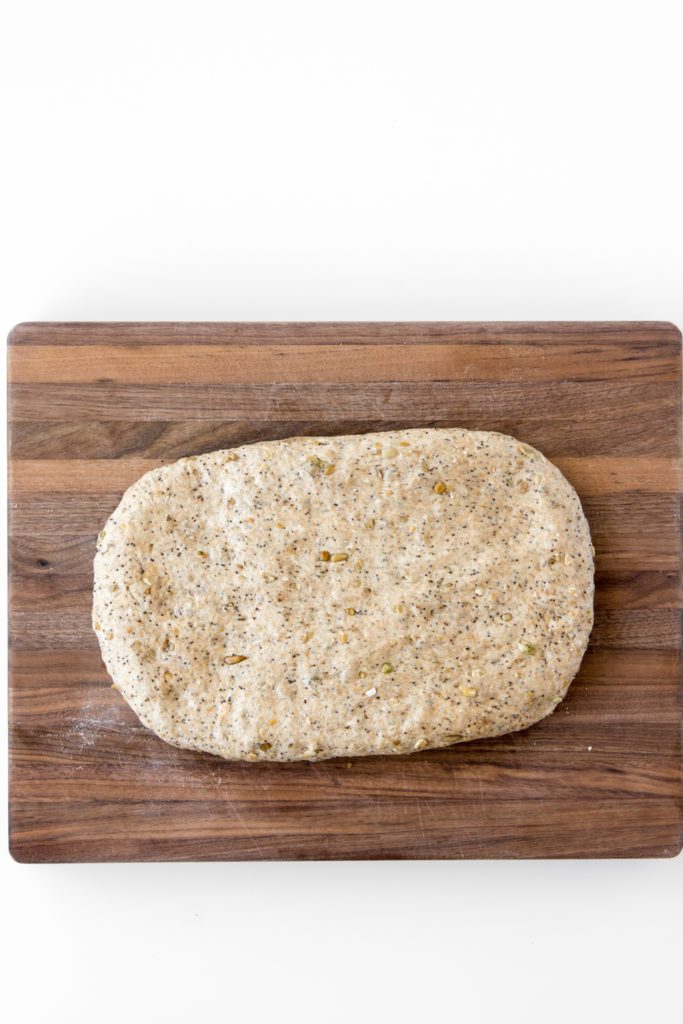

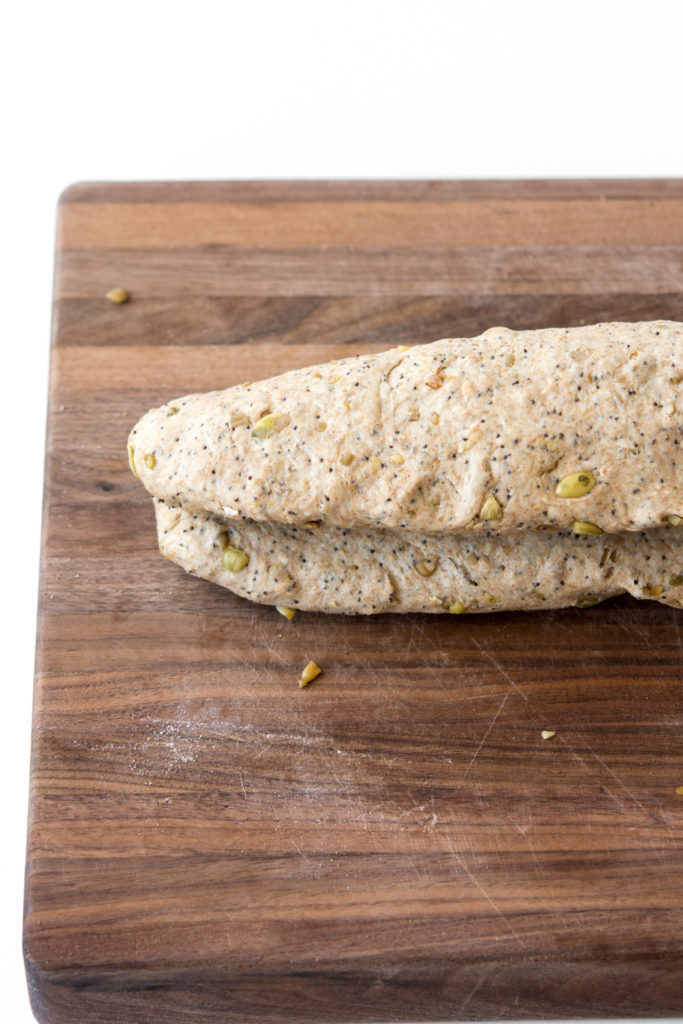
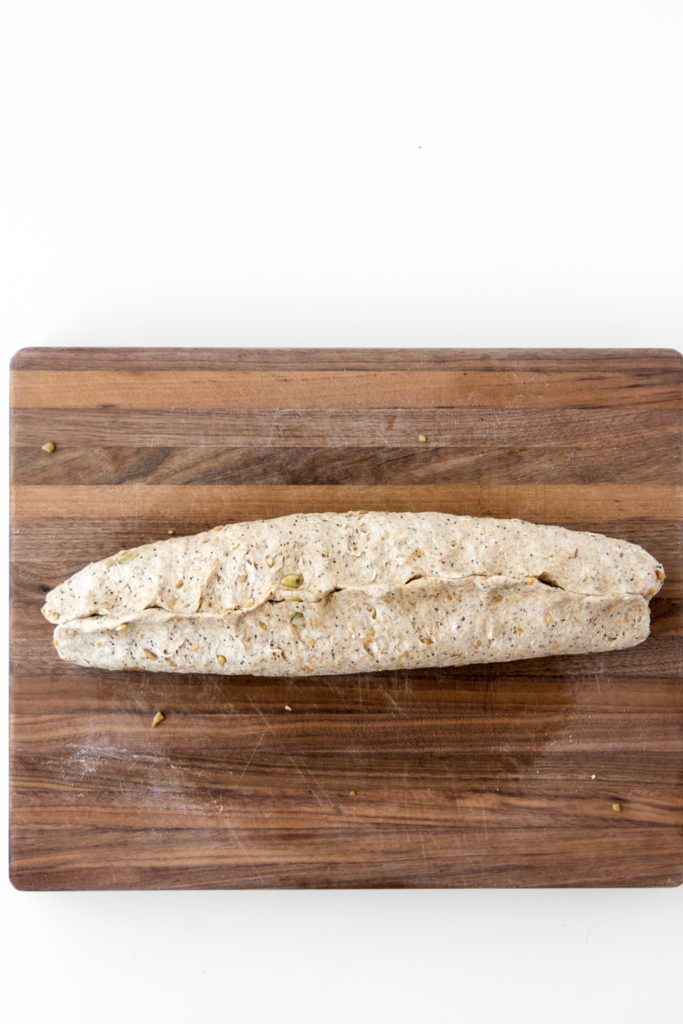
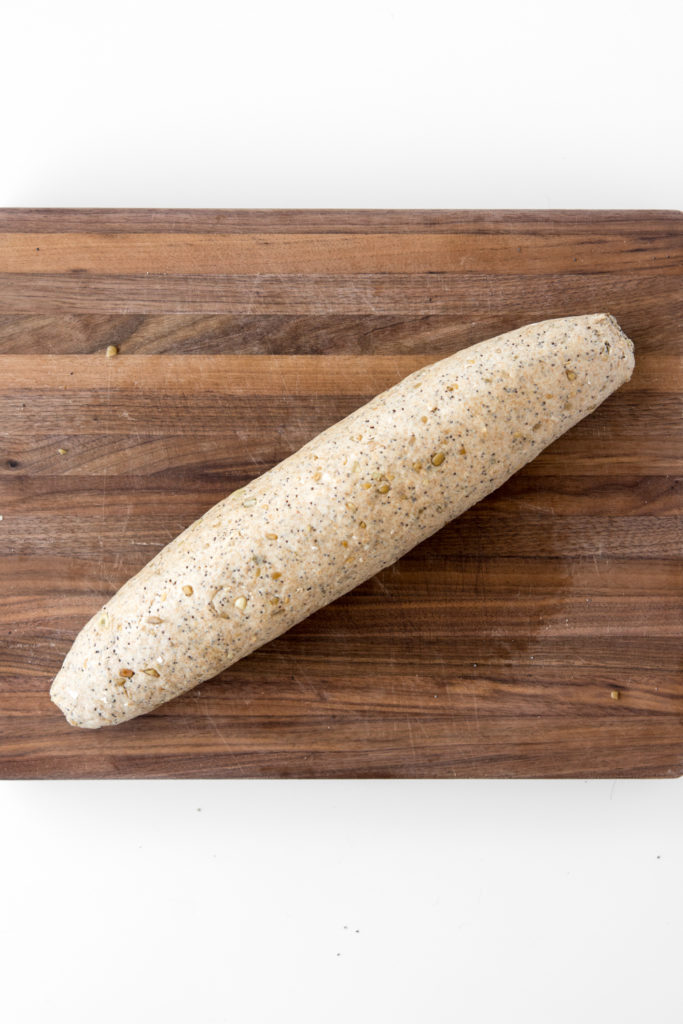
notes on how to make the seed bread:
- time frame:
- the soaker and biga must be made at least 12 hours ahead of time
- the biga needs 2 hours to warm up from the fridge the next day
- the rising takes a total of 2-3 hours
- baking is about an hour
- the term biga, as Peter uses it, refers to a commercial yeast starter that is made the day before with instant yeast. If using active dry yeast, increase the amount by 25% and dissolve it in 2 ounces of warm water, then subtract this amount of water from total water in the recipe.
- if you don’t have the recommended seeds on hand, feel free to mix and match the seeds you do have for a total of 18 tbsp in the dough. If using flax seeds, make sure to soak them overnight.
- you can also mix and match seeds in the topping: either cover in sesame seeds or use a combination of seeds (about 3 tbsp total). If coating with bigger seeds, like sunflower or pumpkin, I tend to brush the loaf with a beaten egg white, rather than water, to help them stick.
- if using a stand mixer, I find it helpful to hand knead the dough in the mixing bowl a few times initially— this and a tablespoon or two of water will help incorporate the seeds in the dough before you start machine mixing
more yeasted bread recipes:
caramelized white chocolate cherry bread
dips and spreads for homemade bread:
saffron aioli (and how to make a grand aioli platter)
whole grain seed bread
This seed bread is thick, hearty and filled with crunchy nutty texture. Enjoy with a thick smear of butter and a sprinkling of flaky sea salt.
- Prep Time: 24 hours
- Cook Time: 45 minutes
- Total Time: 24 hours 45 minutes
- Yield: 1
- Category: Bread
- Cuisine: American
Ingredients
soaker
- 1 ⅓ cups (6 oz, 170 g) whole wheat flour
- 7 tbsp (2 oz, 56.5 g) rye flour
- 2 ¼ tsp (0.25 oz, 7 g) flaxseeds, ground or whole
- ½ tsp (0.14 oz, 4 g) table salt
- ¾ cup (6 oz, 170 g) water
biga
- 1 ¾ cups (8 oz, 227 g) unbleached bread flour or high-gluten flour
- ¼ tsp (0.03 oz, 1 g) instant yeast
- ½ cup + 2 tbsp (5 oz, 142 g) filtered or spring water, room temperature
final dough
- all of the soaker
- all of the biga
- 7 tbsp (2 oz, 56.5 g) whole wheat flour
- 6 tbsp (2 oz, 56.5 g) sesame seeds
- 6 tbsp (2 oz, 56.5 g) sunflower seeds, lightly toasted
- 6 tbsp (2 oz, 56.5 g) pumpkin seeds, lightly toasted
- ⅝ tsp (0.18 oz, 5 g) table salt
- 2 ¼ tsp (0.25 oz, 7 g) instant yeast
- 1 ½ tbsp (1 oz, 28.5 g) honey or agave nectar (or 2 tbsp sugar or brown sugar)
- extra whole wheat flour
- extra sesame seeds for topping (optional)
Instructions
soaker
- Mix all of the soaker ingredients together in a bowl for about 1 minute, until all of the flour is hydrated and the ingredients form a ball of dough.
- Cover with plastic wrap and leave at room temperature for 12 to 24 hours. (If it will be more than 24 hours, place the soaker in the refrigerator; it will be good for up to 3 days. Remove it 2 hours before mixing the final dough to take off the chill.)
biga
- Mix all of the biga ingredients together in a bowl to form a ball of dough. Using wet hands, knead the dough in the bowl for 2 minutes to be sure all of the ingredients are evenly distributed and the flour is fully hydrated. The dough should feel very tacky. Let the dough rest for 5 minutes, then knead it again with wet hands for 1 minute. The dough will become smoother but still be tacky.
- Transfer the dough to a clean bowl, cover tightly with plastic wrap, and refrigerate for at least 8 hours and up to 3 days.
- About 2 hours before mixing the final dough, remove the biga from the refrigerator to take off the chill. It will have risen slightly but need not have rise significantly in order to use it in the final dough.
final dough
- Using a metal pastry scraper or knife, chop the soaker and the biga into 12 smaller pieces each (sprinkle some of the extra flour over the pre-doughs to keep the pieces from sticking back to each other).
- If mixing by hand, combine the soaker and biga pieces in a bowl with the 7 tbsp flour and the seeds, salt, yeast and honey. Stir vigorously with a mixing spoon or knead with wet hands for about 2 minutes, until all of the ingredients are evenly integrated and distributed into the dough. The dough should be soft and slightly sticky; if not, add more flour or water as needed. If using a stand mixer, put the pre-dough pieces in the bowl along with the 7 tbsp flour and the seeds, salt, yeast and honey. Mix on slow speed with the paddle attachment (preferable) or dough hook for 1 minute to bring the ingredients together into a ball (I think wet hands are more effective here). Switch to the dough hook if need be and mix on medium-low speed, occasionally scraping down the bowl, for 3 to 4 minutes, until the pre-doughs become cohesive and assimilated into each other. Add more flour or water as needed until the dough is soft and slightly sticky.
- Dust a work surface with flour, then roll the dough in the flour to coat. Knead the dough by hand for 3 to 4 minutes, incorporating only as much extra flour as needed, until the dough feels soft and tacky, but not sticky. Form the dough into a ball and let it rest on the work surface for 5 minutes while you prepare a clean, lightly oiled bow.
- Resume kneading the dough for 1 minute to strength the gluten and make any final flour or water adjustments. The dough should have strength and pass the windowpane test, yet still feel soft, supple and very tacky. Form the dough into a ball and place it in the prepared bowl, rolling to coat with oil. Cover loosely with plastic wrap and let rise at room temperature for approximately 45 to 60 minutes, until it is about 1 ½ times its original size.
- Transfer the dough to a lightly floured work surface and form it into a freestanding batard (see pictures):
- Gently pat the risen dough into a thick rectangle. Fold the bottom half to the center and press with your fingertips to hold in place and create a seam. Fold the top half to the center and again, press with your fingers to seal and seam.
- Roll the top half over the seam to create a new seam on the bottom of the loaf. Pinch it closed with your fingertips or the edge of your hand to create surface tension on the outer skin, making a tight loaf.
- Rock and roll the loaf to extend it to the desired length, typically 8 to 10 inches. To create a torpedo shape, taper it slightly at each end with increased hand pressure.
- Place the loaf on a proofing cloth or on a sheet pan lined with parchment paper and, if you like, dusted with flour. Brush the top of the dough with water and generously sprinkle with sesame seeds on top. Cover loosely with plastic wrap and let rise at room temperature for approximately 45 to 60 minutes, until it is about 1 ½ times its original size.
- Place a cast iron baking pan or rimmed sheet pan on the shelf immediately above or below the baking shelf in the oven (this will be the steam pan) and preheat the oven to 425°F.
- When the dough is ready to bake, score it and place it in the oven. Pour 1 cup of hot water into the steam pan, lower the temperature to 375°F, and bake for 15 minutes. Rotate the loaf 180 degrees and continue baking for another 20 to 30 minutes, until the loaf is a rich brown on all sides, sounds hollow when thumped on the bottom, and registers at least 200°F in the center.
- Transfer the bread to a cooling rack and allow it to cool for 1 hour before serving.
Notes
makes 1 loaf | recipe from Peter Reinhart’s Whole Grain Breads
Nutrition
- Serving Size: 1/12th of loaf
- Calories: 209
- Sugar: 2.4g
- Sodium: 460mg
- Fat: 5.2g
- Saturated Fat: 0.7g
- Unsaturated Fat: 5g
- Trans Fat: 0g
- Carbohydrates: 35g
- Fiber: 4.3g
- Protein: 7.3g
- Cholesterol: 0mg
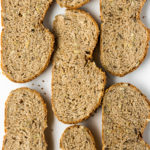
Alice says
Looks great - will need to try!
Indi Hampton says
it's my new favorite bread!